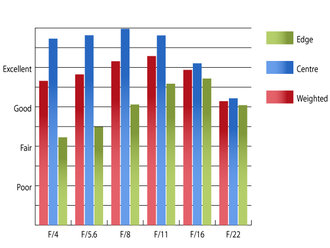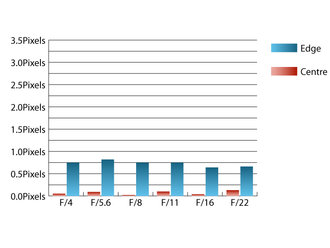Yasuhara Madoka 180 7.3mm f/4 Sony NEX Fisheye Lens Review
Yasuhara Madoka 180 7.3mm f/4 Fisheye Lens Performance
As is often the case with fisheye lenses, sharpness in the centre is outstanding wide open, but as you get closer to the edge of the image circle, clarity falls away to fair levels. Stopping down improves sharpness across the image circle with peak sharpness in the centre being achieved at f/8 and between f/11 and f/16 for maximum sharpness across the image circle. Resolution at 7.3mm | How to read our chartsThe blue column represents readings from the centre of the picture frame at the various apertures and the green is from the edges. Averaging them out gives the red weighted column.The scale on the left side is an indication of actual image resolution. The taller the column, the better the lens performance. Simple. For this review, the lens was tested on a Sony NEX-3 using Imatest. |
For a circular fisheye, chromatic aberrations are very well controlled. Although fringing covering 0.758 pixel width may begin to be visible along high contrast edges towards the edges of the image circle, this level isn't all that severe and is much lower than many other fisheye lenses we have tested so far.
 Chromatic aberrations at 7.3mm | How to read our chartsChromatic aberration is the lens' inability to focus on the sensor or film all colours of visible light at the same point. Severe chromatic aberration gives a noticeable fringing or a halo effect around sharp edges within the picture. It can be cured in software.Apochromatic lenses have special lens elements (aspheric, extra-low dispersion etc) to minimize the problem, hence they usually cost more. For this review, the lens was tested on a Sony NEX-3 using Imatest. |
Distortion is as you might expect for a fisheye, with straight lines towards the edges of the image circle curving wildly. Projection is quite close to orthographic, with objects towards the edges of the frame appearing squished into a tiny space.
It is not possible to formally test light falloff with a circular fisheye. Visually, illumination is even across the image circle with the lens stopped down to f/5.6 or beyond.
Some flare, loss of contrast and internal reflections can be seen in images with a strong source of light in the frame. This only really causes issues in extreme circumstances though and contrast remains good.
Add your message
Login required
Please login here or if you've not registered, you can register here. Registering is safe, quick and free.
Please login here or if you've not registered, you can register here. Registering is safe, quick and free.
photodo Stats
1102 lenses
428 MTF tests
74 in-depth photodo reviews
100+ users join each day
Help the lens community by reviewing or rating a lens today via our lens search
428 MTF tests
74 in-depth photodo reviews
100+ users join each day
Help the lens community by reviewing or rating a lens today via our lens search
Latest Lens Reviews
- Chinon 28mm f/2.8 Vintage Lens Review
- Canon EF 70-200mm f/4L IS II USM Lens Review
- Samyang AF 85mm f/1.4 EF Review
- Sigma 70mm f/2.8 DG Macro Art Review
- Samyang AF 24mm f/2.8 FE Review
- Meike 50mm f/1.7 Review
- Tamron 70-210mm f/4 Di VC USD Review
- Lensbaby Burnside 35mm f/2.8 Review
- Asahi Super Takumar 50mm f/1.4 Review
- Asahi Super-Multi-Coated Takumar 135mm f/3.5 Review
